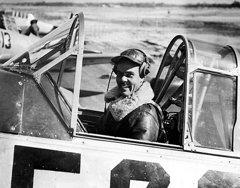In this image we see Captain Benjamin Oliver Davis, leader of the 99th Pursuit Squadron, in the cockpit of a trainer at the airfield in Tuskegee, Alabama on the 23rd of January, 1942. Image online via U.S Air Force.
In late 1942, the 99th Pursuit Squad had company at the Tuskegee Army Air Field. Three more in-training squadrons - the 100th, the 301st and the 302nd - joined with the original squad to expand the number of all-black flight crews. (Eventually, the four squads would form a single unit: the 332nd Fighter Group.)
Comprised entirely of African-Americans, with Lt. Colonel Benjamin O. Davis - a black officer with West Point credentials - in charge, the already-qualified flying team (the 99th) expected to fight for their country at the first-possible opportunity. Months passed, however, without orders for the men to ship overseas. No one, apparently, knew where to send them.
Keen to see action, the twenty-nine pilots of the 99th - and their flight-maintenance colleagues - finally learned they were joining the war in April of 1943. Bound for north Africa, the 99th - after completing additional training in Morocco - would initially fly out of Cape Bon, Tunisia.
Their early assignment was to man P-40L single-seat fighters. Their missions - in connection with the 12th Army Air Force - were tactical operations involving strafing, and dive-bombing, against ground-based enemy targets.
Four pilots of the 99th - William Campbell, Charles Hall, Clarence Jamison and James Wiley - flew the squadron's first war mission the first week of June, 1943. Heading north from their base, they flew to Pantelleria (a small Mediterranean island, west of Sicily, which housed an Italian garrison).
Six days later, six pilots from the 99th - led by Charles Dryden - encountered German fighter planes. Although the pilots downed no enemey aircraft in their first aerial-combat action, their efforts contributed to Pantelleria's surrender on June 11th.
Later that month, the 99th joined with other American fighters as they escorted bombers over the coast of Sicily. In early July, Charles Hall - known as "Seabuster" to his buddies - shot-down a German Fw-190 (a sophisticated plane with an impressive cockpit). His was the first - and only - "scoreboard hit" of 1943.
Although the men of the 99th didn't realize it, their survival as a combat unit was in serious jeopardy.
Beyond the normal discrimination they routinely endured, the men were considered unfit combat pilots. Colonel William ("Spike") Momyer - commanding officer of the 33rd Fighter Group of which the 99th was a part - complained that the all-black squadron had a lousy combat record, especially when compared to white units. He wrote a report about his perceptions in September of 1943.
Momyer's insinuations - about a lack of flying discipline and aggressiveness - was supported by many in the chain of command and had to be addressed. Col. Davis was called-back to the States. The ostensible reason for his return was to take command of the newly formed 332nd Fighter Group. A more significant reason was to defend the 99th's record in the face of Momyer's allegations.
At a Pentagon press conference - with his father at his side - Ben Davis condemned the very thought that "the utilization of black men as pilots had to be regarded as an experiment." General George Marshall - then the Army Chief of Staff - wanted more evidence before recommending any action to the President. He assigned the task to Army G-3 (Operations).
In its September 20, 1943 issue, TIME magazine ran a story which featured Momyer's allegations and Davis' response:
So little operational data on the 99th had reached Washington that it was impossible to form a conclusive opinion about its pilots. It has apparently seen little action, compared to many other units and seems to have done fairly well, that is as far as anyone would go...
...Most thoughtful Army officers probably would agree that the Negro will never develop his potentialities as an airman or any other kind of soldier under the system of segregation in training.
Then - referencing "the Negro pilot training experiment," the TIME reporter continues:
This squadron, too, is an experiment, and will be one until a question as old as U.S. independence is answered: Is the Negro as good a soldier as the white man? (Quoted by Gail Lumet Buckley in American Patriots, at pages 352-3.)
The men of the 99th - and the rest of the newly formed 332nd Fighter Group - would soon have an opportunity to answer that question. G-3 had concluded there wasn't enough evidence to pull black pilots from combat and recommended the unit be given a true test in the Mediterranean area of operations.


 Back
Back
 Next Chapter
Next Chapter

 Back
Back
 Next Chapter
Next Chapter


